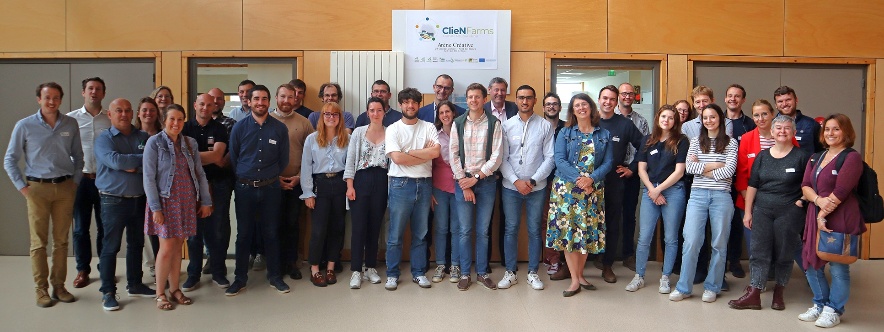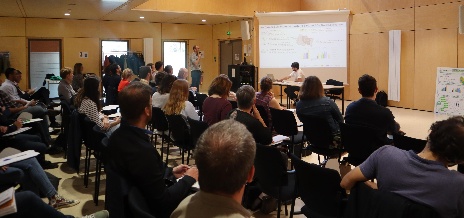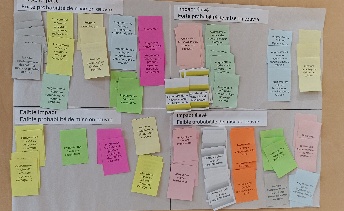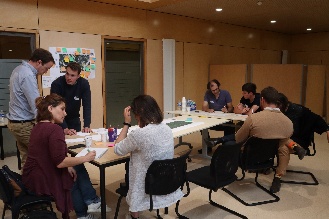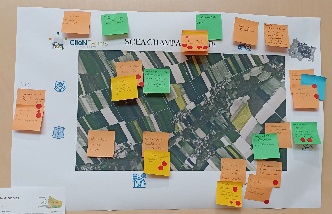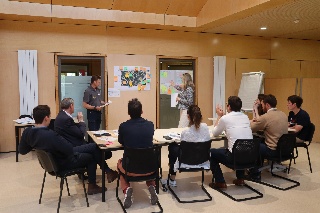ClieNFarms Creative Arena in the I3S-NE of France
To target a low-carbon agriculture in the Grand Est region
At the beginning of September, thirty stakeholders from the agricultural sector in the Grand Est region gathered at the Aube and Haute-Marne Chamber of Agriculture for the second edition of ClieNFarms Creative Arena in this region. This event provided an opportunity to take stock of regional actions as the European project draws to a close.

Three years of experimentation on pilot farms
Eight lead commercial farms were monitored for three years to test various low-carbon levers. The result: an average reduction in greenhouse gas (GHG) emissions of 0.4 teqCO2/ha/year. The variability around this average, which is even better than initial simulations, highlights the complexity of the dynamics which are involved. As Mathieu Dulot, development engineer at Terres Inovia, points out, “the effects of the measures tested vary greatly depending on soil and climate conditions and farm types.” In addition to the farm context, there are external factors, such as climatic hazards, which have a significant influence on results, and the economic context, which may or may not facilitate changes in practices, particularly fertilisation.
What levers can be used to reduce the carbon footprint?
Among the levers which have been tested, some stand out for their effectiveness:
- Reducing mineral nitrogen inputs (effect on emissions);
- The introduction of cover crops (effect on carbon storage);
- The integration of leguminous crops or low-input crops into crop rotations (effect on emissions).
However, their large-scale deployment raises questions:
- Are there sufficiently attractive and sustainable economic opportunities to allow the introduction of new crops?
- What impact will other crops have on current supply chains and local agri-food industries?
- How can changes in practices and rotations be implemented while maintaining production and income?
The shared conclusion is clear: reflection at the regional level is essential to support the low-carbon transition.
The example of Scara: subsidies to support farmers
The Scara agricultural cooperative, the first in France to be ISO 14067 certified, presented its support scheme. Thanks to this certification, it is introducing low-carbon sector premiums to provide financial support to farmers as they change their practices, while meeting the expectations of its industrial customers.
Adel Laoussadi emphasises, “We are seeing encouraging growth in low-carbon volumes, particularly for malting barley and wheat.” This trend can be explained both by increased demand from customers committed to SBTi trajectories and by the effectiveness of the measures implemented by Scara and tested over several years. The SBTi standard sets a target of reducing emissions by 36% between 2020 and 2030 for cereals.
To achieve these targets, the cooperative is deploying several concrete levers:
- Reducing mineral nitrogen inputs ;
- Adding urease and nitrification inhibitors to nitrogen fertilisers;
- Using decision-making tools, in particular xylem sap analysis, which enables a more accurate assessment of crop nutrient requirements, which are then applied via foliar feeding.
Low-carbon transition in the Grand Est region: reconciling the economy and the environment
With its capacity to store carbon and reduce emissions, French agriculture has a key role to play in achieving the objectives set by the National Low-Carbon Strategy of France. In the scope of ClieNFarms scaling-up actions, a study, conducted by Terres Inovia in 2025, on the territorial extrapolation of possible levers upon the basis of cropping systems representative of the diversity of situations, highlighted the potential of agriculture in the Grand Est region to reduce its net GHG emissions.
As Anne Schneider of Terres Inovia points out, “the estimated mitigation potential at the Grand Est level can be higher than that considered at the level of individual farm situations. To achieve this result, we must focus on ambitious practices that are adapted to local realities and not hesitate to radically rethink crop rotations and their management.”
Technical and financial support for farmers and a collective organisation of the regional transition must be gradually developed in order to achieve this potential. Etienne Lapierre of Terrasolis, referring to the prospective study conducted in 2024 by IDDRI on the case of Champagne-Ardenne, highlights the need to make the low-carbon transition compatible with the reality of the industrial fabric and jobs in a region.
Reminder of the conclusions of the June 2024 creative arena
The first regional creative arena organised in June 2024 brought together a multi-stakeholder group of 45 participants. Working in groups, they were tasked with identifying mitigation levers considered to be “impactful” and “probable” in arable farming. For the three working groups, this category included increasing cover crops and using fertilisers with lower emissions.
The courses of action defined in three different local situations highlighted the following common points:
- Stronger communication on the benefits for each stakeholder (producers, manufacturers, decision-makers, citizens) of taking ownership of carbon issues;
- Widespread training in low-carbon practices by pooling the skills of advisers from different organisations;
- The massification of offers enabling risk and investment sharing in the context of low-carbon transition, by involving farmers in the design of strategies;
- Strengthening research to better understand the processes linking practices and climate change mitigation;
- A clear policy and regulatory framework that rewards virtuous low-carbon actions.
